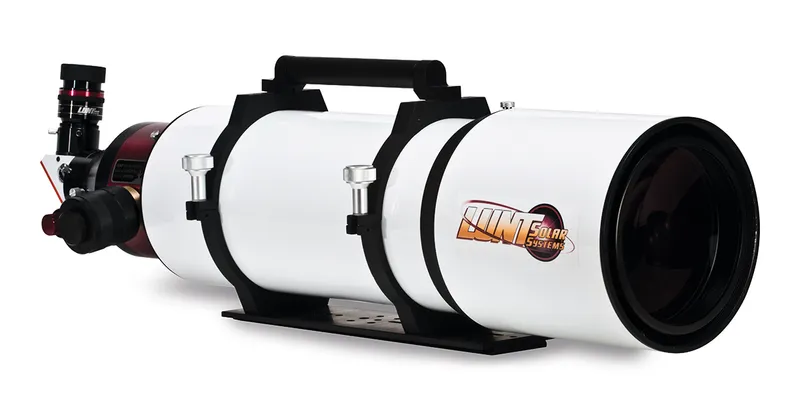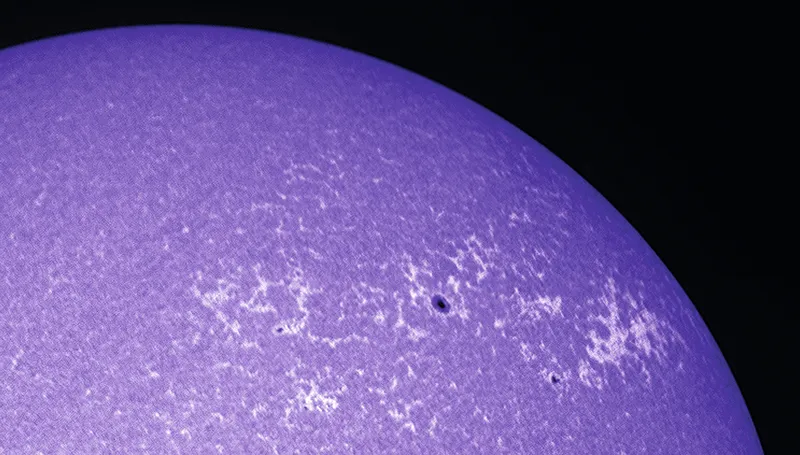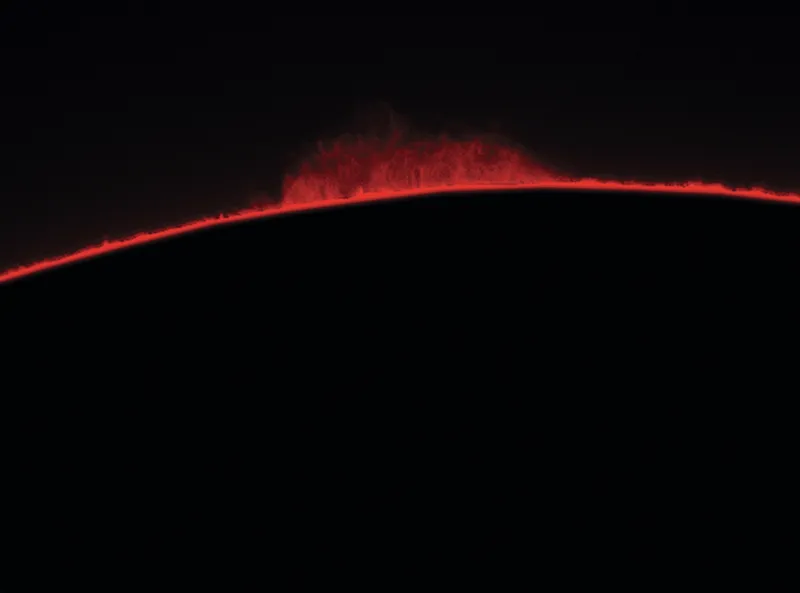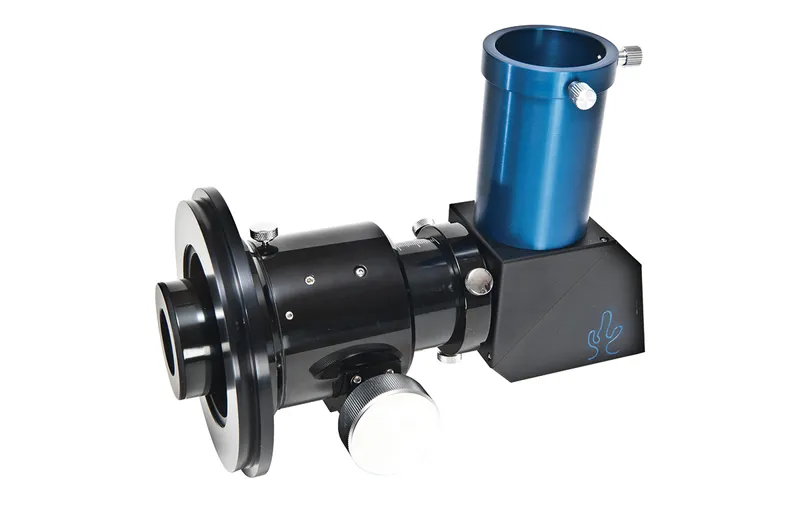The Lunt LS152THa is a 6-inch hydrogen-alpha (h-alpha) telescope, one of the largest currently available.
It’s specifically designed for solar observing; pointing it at the Sun reveals one of the inner layers of its atmosphere called the chromosphere, an area where you’ll never be short of things to look at.
The chromosphere is covered in dark mottles, which collectively give it an ‘orange peel’ appearance.
Bright plages and twisting dark fibrils are often visible, revealing the presence of magnetically active regions poking through the chromosphere.
- Buy the Lunt LS152Ha solar telescope from Lunt Solar Systems

Dark, snake-like features known as filaments may also be seen.
When these reach the edge of the Sun, they can appear as huge projections off its limb called solar prominences.
These features change in relatively short timescales – typically days, but sometimes hours or minutes.
The LS152THa is extremely well-engineered and solidly built.
Given that it weighs a little over 13kg, it’s good to see that Lunt has added a handle to the scope’s tube rings, making it easy to lift out of its sturdy foam-lined case.
With a retractable dew shield, this weighty scope is actually quite easy to transport.
To see h-alpha detail, you need a precision filter to limit the light passing through the scope to a narrow range of wavelengths centred on 656.28nm.
The range of wavelengths that a filter lets though is known as its bandpass.
For the LS152THa, this is quoted as less than 0.065nm.
This means that the scope is great for revealing fine detail in and above the chromosphere as well as keeping prominences bright and structurally detailed.
Read our guides on how to observe the Sun safely and how to see sunspots.

The 1.25-inch, 21.5-7.2mm zoom eyepiece supplied complements the scope well, providing magnification from 42x to 125x.
At lowest magnification the Sun’s disc comfortably fits into the field of view.
A generous, 18mm-diameter B1800 blocking filter provides a good amount of sky around the Sun at low power.
This view is quite astonishing; to us, the Sun really did look like a three-dimensional star hanging in space.
Observing solar surface detail

There were several small active sunspot regions visible during our test run, and we were pleased that the zoom eyepiece allowed us to get a close look at the action.
Plenty of surface detail was visible and the resolution was very good.
We were able to see a layer of hydrogen plasma jets, known as spicules, at the edge of the Sun quite easily with this setup.
Although spicules are typically several thousand kilometres in length, they are quite thin in solar terms.
Seeing them packed together at the Sun’s limb made our star’s edge look almost furry.
The ‘magic’ that allows you to see all of these amazing features is provided by an optical device known as an etalon.
This consists of two semi-reflective, optically flat plates held parallel to one another.
The flatness of the plates and how parallel they are is what defines the quality of the view.
The tolerances required here are eyewatering, and the reason why h-alpha scopes are more expensive to manufacture than normal scopes.
Want to observe a solar eclipse? Find out when the next eclipse is taking place.

The LS152THa overcomes the prohibitively high cost of a full-aperture 6-inch etalon by using a 2.5-inch unobstructed one further down the optical path from the main objective lens.
The term ‘unobstructed’ means that no internal spacers have been used in the light path to help hold the plates parallel.
We were very impressed with the LS152THa.
The whole scope has a quality feel to it and is well thought out.
In addition to h-alpha viewing, the scope is designed to accept different filter systems
And with a massive 6-inch aperture to play with you can effectively create your own solar viewing laboratory in your back garden.
Lunt LS152THa solar telescope modular system

The LS152THa is a modular system based around a 6-inch objective lens; the objective feeds light to a filter system designed for h-alpha viewing.
However, undo the set screws holding the filter assembly in place and it’s possible to replace the h-alpha module with a different filter.
We trialled the optional Lunt calcium-K (Ca-K) filter, which is centred on the 393.4nm wavelength and has a 0.24nm bandpass.
Sunspot groups stand out beautifully in this deep purple-blue wavelength, and glowing calcium ions pick out a large web of bright cells known as the chromospheric network.
With the 6-inch aperture feeding the filter, it’s possible to see Ca-K features visually through the eyepiece, although the best results are obtained with a camera.
The Ca-K unit comes with a Starlight Instruments Feather Touch focuser, making it a completely standalone module.
The Ca-K filter can be removed, allowing the scope to be used as a 6-inch achromatic refractor for night viewing or, with the addition of a white light Herschel wedge, as a white light solar telescope.
Lunt LS152THa solar telescope best features
Aperture
As solar telescopes go, this one’s a bit of a monster. Its 6-inch achromatic objective delivers a converging beam of light towards the h-alpha filter assembly at the rear of the scope.
The light is collimated into a parallel beam before it passes through the etalon, a necessary condition for the etalon to work properly.
Tube rings
The tube rings incorporate a very sensible carry handle, and this – along with the retractable dew shield – makes this scope remarkably easy to transport despite its considerable size and weight.
The Widescreen Centre can also supply a Vixen- or Losmandy-compatible dovetail that fits to the tube rings for mounting.
Focuser
The dual-speed focuser provides plenty of travel for the most demanding imaging or visual setups. It’s responsive and allows you to quickly rough focus before finely snapping everything into view.
A blocking filter diagonal needs to be inserted to complete the h-alpha filter assembly; this scope is supplied with the B1800.
Zoom eyepiece
The supplied 21.5-7.2mm zoom eyepiece complements the setup beautifully.
It allows you to zoom right out to see the entire Sun in one go, or home in on intricate details in the chromosphere or the prominences extending off the Sun’s limb.
Pressure tuning
Changes in atmospheric pressure can alter the gap between an etalon’s plates, causing the filter to go ‘off-band’. Lunt’s clever solution to this is a pressure tuning system.
Rotating a knob on the side of the filter unit changes the pressure in the etalon chamber, moving the plates by tiny amounts to bring the filter ‘on-band’ again.
Vital stats
- Price: £8,999 (h-alpha only); £10,698 (h-alpha & calcium-K)
- Focal length: 900mm; f/6
- Aperture: 152mm (6 inches)
- Bandpass: <0.065nm at 656.28nm (h-alpha); 0.24nm at 393.4nm (calcium-K)
- Etalon: Unobstructed 60mm h-alpha; matching B1800 blocking filter supplied
- Finder: Tele Vue Sol-Searcher
- Focuser: Starlight Instruments Feather Touch
- Weight: 13.3kg
- Supplier: The Widescreen Centre
- Tel: 020 7935 2580
- www.widescreen-centre.co.uk
This telescope features in our list of the best solar telescopes.
This review originally appeared in the June 2012 issue of BBC Sky at Night Magazine.
